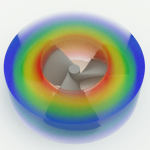
Windy Trees: Computing Stress Response for Developmental Tree Models
We present a novel method for combining developmental tree models with turbulent wind fields. Our tree models react in real-time to changes of the wind simulation and adapt to long-term wind stress. Additionally, the system allows modeling biological effects such as branch breaking as well as bud abrasion and drying.
Soeren Pirk, University of Konstanz
Till Niese, University of Konstanz
Bedrich Benes, Purdue University
Oliver Deussen, University of Konstanz
Torsten Hädrich, University Of Konstanz

SPGrid: A Sparse Paged Grid Structure Applied to Adaptive Smoke Simulation
We propose a new data structure SPGrid for storing sparse data sets that rivals the efficiency of uniform grids. Using a pyramid of SPGrids, we efficiently emulate an octree for simulating adaptive fluid dynamics. We also present an adaptive Multigrid preconditioned Krylov solver that achieves resolution independent convergence rates.
Rajsekhar Setaluri, University Of Wisconsin - Madison
Mridul Aanjaneya, University of Wisconsin - Madison
Sean Bauer, University of Wisconsin - Madison
Eftychios Sifakis, University of Wisconsin-Madison

A PPPM Fast Summation Method for Fluids and Beyond
The particle-particle particle-mesh method computes n-body summation in linear time, providing solution to turbulent flow modeling using large number of vortex particle and boundary elements.
Xinxin Zhang, University Of British Columbia
Robert Bridson, Autodesk

Multiple-fluid SPH Simulation Using a Mixture Model
This paper presents a versatile and robust SPH simulation approach for multiple-fluid flows using an improved mixture model. The new approach can capture a wide range of realworld multiple-fluid phenomena, and is easy to implement as an extension to existing single-phase fluid simulators.
Bo Ren, Department of Computer Science and Technology, Beijing Tsinghua University
Chenfeng Li, College Of Engineering, Swansea University
Xiao Yan, Department Of Computer Science And Technology, Beijing Tsinghua University
Ming Lin, Department Of Computer Science, University Of North Carolina At Chapel Hill
Javier Bonet, College Of Engineering, Swansea University
Shi-min Hu, Department Of Computer Science And Technology, Beijing Tsinghua University

Yarn-Level Simulation of Woven Cloth
We introduce an efficient solution for simulating woven cloth at the yarn level by modeling yarn-yarn contact implicitly through a novel discretization of interlaced yarns. We simulate garments with hundreds of thousands of yarn crossings, showing large- and fine-scale effects (snags, detailed tearing) induced by yarn-level mechanics.
Gabriel Cirio, Universidad Rey Juan Carlos
Jorge Lopez-Moreno, Universidad Rey Juan Carlos
David Miraut, Universidad Rey Juan Carlos
Miguel Otaduy, Universidad Rey Juan Carlos
 English
English 
